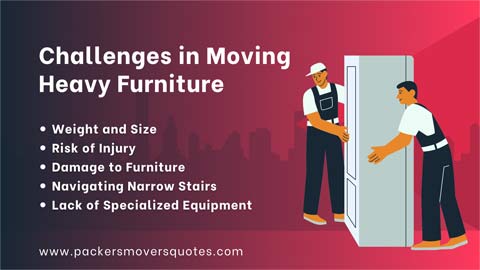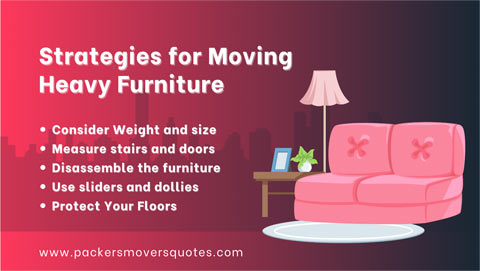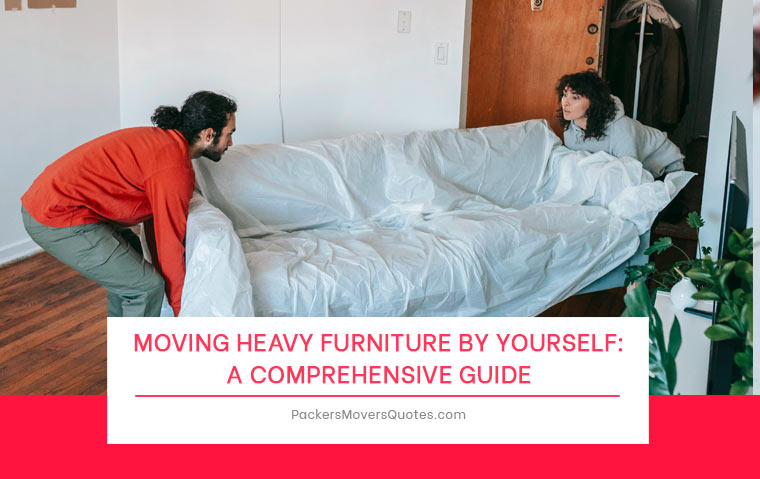Moving heavy furniture can be a formidable task, especially if you’re doing it on your own. The sheer weight, bulkiness, and potential for damage pose challenges that require careful consideration.
But with the right approach and a bit of planning, you can successfully navigate this aspect of your move without the need for professional help.
In this comprehensive guide, we’ll explore the common challenges involved in moving heavy household furniture and provide practical solutions to help you tackle them effectively.
The Challenges Involved in Moving Heavy Furniture

- Weight and Size
Moving heavy furniture items often involves dealing with substantial weight and awkward dimensions. Manoeuvring items like sofas, wardrobes, and cabinets through doorways and tight spaces can be particularly challenging. - Risk of Injury
Lifting and transporting heavy items incorrectly can lead to personal injuries, including strains and muscle sprains. It’s crucial to prioritize safety to prevent accidents during the moving process. - Damage to Furniture
The risk of damaging your furniture is heightened when dealing with heavy items. Scrapes, dents, and even structural damage can occur if not handled with care. - Navigating Stairs and Narrow Spaces
Negotiating stairs and navigating narrow hallways or doorways with heavy furniture items can be a logistical puzzle. Without a well-thought-out plan, it’s easy to get stuck or cause damage to the furniture and surrounding areas. - Lack of Specialized Equipment
Professional movers often use specialized equipment like dollies and straps to move heavy items efficiently. When moving on your own, the absence of such tools can make the process more challenging.
Solutions: How to Overcome These Challenges
Now that we’ve identified the challenges, let’s delve into practical solutions to ensure a smooth and successful move of heavy household furniture on your own.
Assessing the Situation
Before diving into the physical aspects of moving heavy furniture, it’s crucial to assess the situation and plan your move accordingly.
Take Inventory
Start by creating a detailed inventory of the heavy furniture items you’ll be moving. This not only helps in organizing the process but also ensures that you have the necessary equipment for each piece.
Measure Doorways and Hallways
Measure the doorways and hallways of both your current and new residence. This ensures that your furniture can pass through without getting stuck.
H3: Gather the Right Tools
Equip yourself with the right tools, including furniture sliders, moving straps, dollies, and protective gear such as gloves and safety glasses.
Strategies for Moving Different Types of Bulky Furniture

Sofas and Couches
- Remove cushions and pillows.
- Use furniture sliders to easily glide the sofa across floors.
- If moving through narrow spaces, tilt the sofa vertically to maneuver more easily.
Dining Tables
- Disassemble the table if possible.
- Wrap table legs in bubble wrap or moving blankets.
- Use a dolly for easy transportation.
Wardrobes and Cabinets
- Empty the contents of wardrobes and cabinets.
- Remove drawers to make them lighter.
- Secure doors with moving straps.
Beds
- Disassemble the bed frame and headboard.
- Wrap mattress and frame separately.
- Utilize moving straps to carry disassembled parts.
Heavy Electronics
- Disconnect and pack electronics separately.
- Use original packaging if available.
- Label cables for easy reassembly.
Moving Day Execution
Enlist Help if Possible
If available, ask friends or family to assist with lifting and manoeuvring heavy items.
Protect Your Back
Bend your knees, not your back, when lifting heavy items.
Use proper lifting techniques and avoid overexertion.
Use Sliders and Dollies
Place furniture sliders under the legs of heavy items for easy movement.
Utilize dollies for larger pieces, especially when navigating stairs.
Secure Furniture in Transit
Use moving straps to secure furniture in the moving vehicle.
Place heavier items at the bottom to ensure stability during transportation.
Safety Tips and Considerations
Prioritize Safety
Wear appropriate protective gear, including gloves and safety glasses.
Take breaks to prevent fatigue and stay hydrated throughout the process.
Protect Your Floors
Use furniture sliders or rugs to protect floors from scratches and dents.
Plan for Stairs
If dealing with stairs, take extra precautions and consider professional help for particularly challenging scenarios.
Know Your Limits
If a piece of furniture is too heavy or cumbersome, consider professional assistance to avoid injuries or damage.
Over to You
Moving heavy household furniture by yourself is undoubtedly a demanding task, but with careful planning and the right techniques, it’s a manageable feat. For Indian working professionals looking to make their move more cost-effective and self-reliant, following these steps will ensure a successful transition.
Remember to prioritize safety, enlist help when needed, and approach each piece with a strategic mindset.
By empowering yourself with the knowledge and tools needed to move heavy furniture independently, you’ll not only save on moving costs but also gain a sense of accomplishment as you settle into your new home.
